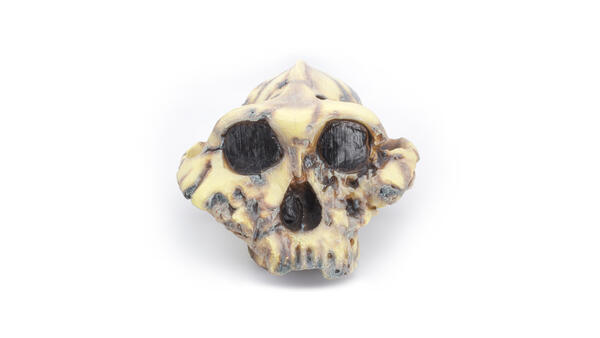The collection of the Irkutsk Regional Museum of Local History has a 3D model of a skull that belonged to Paranthropus Boisei.
Paranthropus Boisei is an early human species. It lived in East Africa about 2.5-1 million years ago. The remains were first found by anthropologists Mary and Louis Leakey in July 1959. They conducted excavations in the Olduvai Gorge in Tanzania and found a skull that differed from all previous finds. It was nicknamed ‘Nutcracker man’ because of the unusual flattened shape of the head and very large teeth.
Scientists also found small stones with roughly processed edges near to the Paranthropus remains. These small stones were primitive tools used by the early humans. Louis suggested that the Paranthropus Boisei was the first out of thw hominin species to make and use such tools. However, a homo habilis skeleton was found at the same place a few months later. Scientists came to the conclusion that the processed stones belonged to him, and the Paranthropus became his prey and died here. This assumption was confirmed by following excavations: primitive tools were often found in close proximity to homo habilis remains.
Mary and Louis ' son Richard Leakey conducted an independent excavation near Lake Turkana in Kenya in 1969. There he discovered a similar ‘Nutcracker man’. It was given a name with Latin letters and numbers — KNMER 406 — and it was determined that it belonged to the same species as the one Leakey’s parents had found. The KNMER 406 peculiarity was that despite its age — 1.7 million years, the skull was preserved almost completely, without any chips or decay.
Paranthropus Boisei had a massive head with a smaller brain volume — 400-500 cm3, which is three times smaller than what modern humans have. It was short, 1.2 to 1.6 meters, and weighed around 40 to 90 kilograms.
Unlike their predecessors, the Paranthropus had a well-developed jaw and facial muscles; according to scientists, it intensively chewed food. It is known that they ate plants: cereals, young trees leaves and wild grass, as well as nuts. Nutshells were often found near their remains.
Paranthropus Boisei is an early human species. It lived in East Africa about 2.5-1 million years ago. The remains were first found by anthropologists Mary and Louis Leakey in July 1959. They conducted excavations in the Olduvai Gorge in Tanzania and found a skull that differed from all previous finds. It was nicknamed ‘Nutcracker man’ because of the unusual flattened shape of the head and very large teeth.
Scientists also found small stones with roughly processed edges near to the Paranthropus remains. These small stones were primitive tools used by the early humans. Louis suggested that the Paranthropus Boisei was the first out of thw hominin species to make and use such tools. However, a homo habilis skeleton was found at the same place a few months later. Scientists came to the conclusion that the processed stones belonged to him, and the Paranthropus became his prey and died here. This assumption was confirmed by following excavations: primitive tools were often found in close proximity to homo habilis remains.
Mary and Louis ' son Richard Leakey conducted an independent excavation near Lake Turkana in Kenya in 1969. There he discovered a similar ‘Nutcracker man’. It was given a name with Latin letters and numbers — KNMER 406 — and it was determined that it belonged to the same species as the one Leakey’s parents had found. The KNMER 406 peculiarity was that despite its age — 1.7 million years, the skull was preserved almost completely, without any chips or decay.
Paranthropus Boisei had a massive head with a smaller brain volume — 400-500 cm3, which is three times smaller than what modern humans have. It was short, 1.2 to 1.6 meters, and weighed around 40 to 90 kilograms.
Unlike their predecessors, the Paranthropus had a well-developed jaw and facial muscles; according to scientists, it intensively chewed food. It is known that they ate plants: cereals, young trees leaves and wild grass, as well as nuts. Nutshells were often found near their remains.



